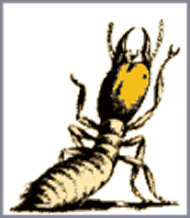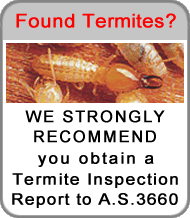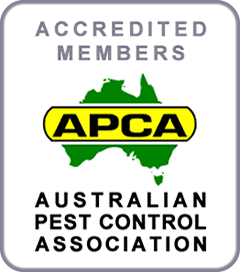 |
 |
 |
|
|
|||||||||||||||||||||||||
| Ants - Pest Control - Ant Baits |
| Found ants in your pantry ? |
|
A social insect - most ant pest species in Australia are advanced social insects - multiple queens, kings, workers and winged reproductives - ants live in permanent colony nests located in a variety of habitats - in the soil - in timber - under pavers - in wall cavities and roof void spaces of buildings.
Thousands in the pantry - ants may travel large distances in search of food - even a very clean kitchen or pantry can provide a ready food source for ants - a sudden extreme infestation by ants in the pantry often occurs in summer - with the pantry covered in ants. A nuisance pest - a few of the ant pest species can inflict a painful bite, but most are a nuisance pest when they infest pantries, kitchens and BBQ areas in large numbers. Summer time is most problematic - the ants are out in force, building up their numbers and searching incessantly for food to be stored in their colony nest for the colder winter months. |
||
| Correct identification - Pest control methods |
|
Correct identification of the particular pest species of ant is vital to implementing a control program.
Some species nest in the ground, others are more likely find a home in your roof void or wall cavity.
Ants inside the building - for internal areas - recommend the application of professional strength Permethrin dust to ant nesting locations found inside a wall cavity - around electrical junction boxes - and in the roof void spaces of your home or commercial building - for external areas apply a combination of ant bait granules and bifenthrin liquid treatment to obvious ant nesting sites and trailing areas. Safer than salt - Permethrin is a natural extract of the pyrethrum plant and is of extremely low toxicity to humans, dogs and other mammals. It can be toxic to cats. Permethrin is less toxic than is table salt. Ants take the bait - recommend seeking a pest controller that uses the latest technology in granular ant baits - professional products - contain an insect growth regulator in a sealed plastic dispenser - installed near high activity areas - foraging ants collect and carry the appertising food bait back to feed the other ants in the colony nest - effective control may take several weeks - a range of ant baits are available - their use depending on whether the ant pest species are sugar feeders or protein eaters. Locating the colony nest is sometimes impracticable as the ants may nest in concealed locations. However, where a nest is found, particularly in the soil then a Pyrethroid liquid insecticide spray can be used directly into the burrow and the colony nests. Effective eradication is assured. |
||
| Some commonly found Ant pest species |
| The main ant pest species found by the homeowner incude the White-footed house ant - Odorous house ant - Coastal brown ant - Carpenter ant - Bulldog ant. | ||
| White-footed house ant |
Biology - colonies of White-footed house ants often contain many satellite colony nesting sites spread over a wide area. Strength in numbers - the entire ant colony may contain several million workers and many queens - White-footed house ants prefer sweet tasting food - sugar - soft drinks and the like. Nesting sites commonly found outdoors - in the ground - in trees - buildings - wall cavities - roof voids architraves and fireplaces - known to infest and short-circuit air conditioners. |
|||
| Odorous house ant |
Biology - Odorous house ant colonies can contain more than 10,000 workers and several reproductive queens used to establish subsidiary colonies. Ants from different colonies are not aggressive toward each other. Nesting sites commonly found outdoors in the soil - under the base of trees - indoors. Odorous house ant colony nests in the soil are usually shallow, situated under a stone, pavers or other flat objects. Inside your home: The odorous house ant commonly nest under buildings and inside wall cavities, particularly if there is a regular moisture source available. Look for moisture problems from faulty plumbing, leaking shower recess, broken guttering and roof tiles. |
|||
| Coastal brown ant |
Size - Coastal brown worker ants are approximately 2 to 3 mm in length. Nesting sites - wall cavities - garden beds and sub-floor areas. |
|||
| Carpenter ant |
Biology - Carpenter ants often enter buildings to nest and forage. They excavate their nests in wood (hence the name "carpenter" ants), creating smooth tunnels and galleries. Carpenter ant colonies may exceed 100,000 workers - with multiple queens and satellite nesting sites - colonies require many years to reach maturity - these ants can travel long distances in search of food. Nesting sites Carpenter ants prefer to build their nests in open areas - in moist wood - in the soil - in twigs and branches - but some species will readily infest and damage timbers in buildings. |
|||
| Bulldog ant |
Nesting sites - Bulldog ants prefer to nest in garden or forest areas. Nasty painful bite - leave them alone - call a professional pest controller |
|||
| Cost estimates - Professional pest control - Ants |
|
| Consumer protection advice - Pesticide safety issues |
| Pesticide safety be wary of very cheap prices for ant control - check which pesticides are to be used - do they propose to use the far cheaper, less effective, solvent based pesticides which can be acutely harmful in premises where occupants may suffer from asthmatic or other bronchial ailments.
Be careful when selecting a pest controller it's far too easy to get a State Govt issued Pest Control Licence and start up a pest control business - using mostly unsupervised trainees who have little knowledge of ant pest species or ant control pesticides .... more details |
||
| For specific information - Click on your problem pest |
|
|||||||||||||||||||||||||||||||||||||||||||||||||||||||||||||||||||||||||||||
|
|||||||||||||||||||||||||
             
|
| Published by the Fumapest Group © Copyright 1995 to - updated |